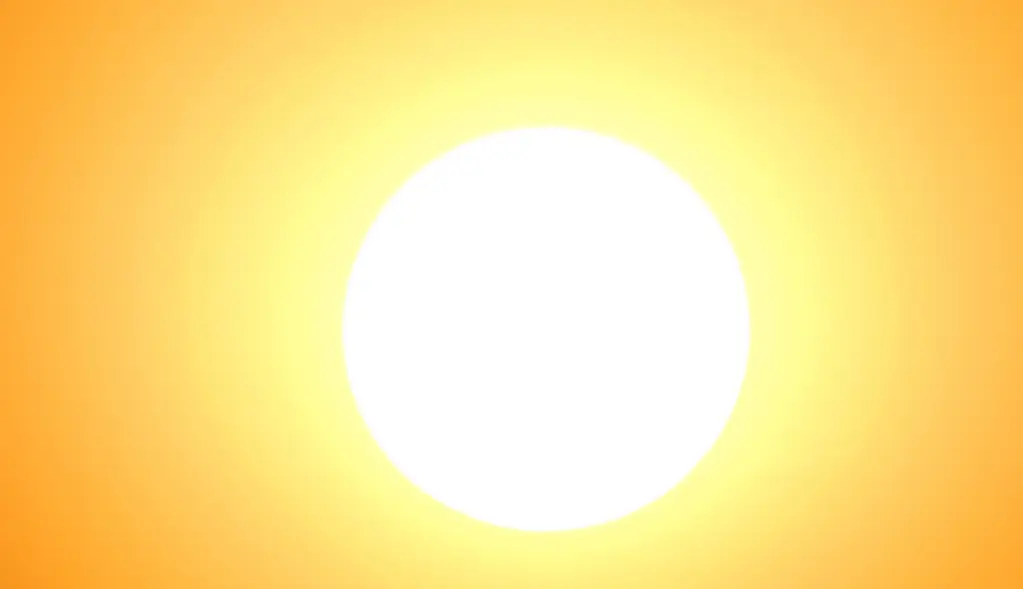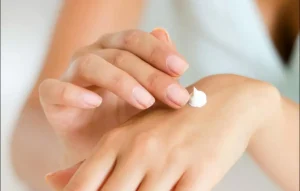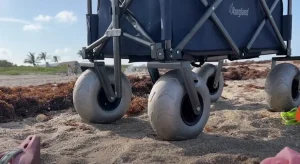To reduce the risk of sun damage, people can apply sunscreen, cover exposed skin, and avoid going out during the hottest times of the day. Risks of excessive sun exposure include sunburn and heatstroke.
Applying Sunscreen
Sunscreen can help prevent sunburn, premature skin aging, and skin cancer.
The American Academy of Dermatology (AAD) recommends choosing a sunscreen with the following attributes:
- SPF 30 or higher
- Broad-spectrum protection against UVA and UVB rays
- Water resistance
People should apply sunscreen about 15 minutes before going outside to allow time for it to absorb into the skin. Then, reapply sunscreen every two hours during outdoor activities, and immediately after sweating heavily or swimming.
When applying sunscreen, it is important to cover all exposed areas, including the lips and scalp.
The U.S. Food and Drug Administration (FDA) states that sunscreen is generally not suitable for infants under 6 months old.
Instead, people should try to keep infants out of direct sunlight, especially between 10 a.m. and 2 p.m., when UV rays are strongest.
Covering Exposed Skin
The Centers for Disease Control and Prevention (CDC) advises covering exposed skin to protect oneself from sun damage. This includes:
- Wearing clothing with good coverage, such as long-sleeved shirts and long pants or skirts
- Wearing clothes made from tightly woven fabrics, as they more effectively block UV rays
- Changing into dry clothes when needed, as wet clothes provide less UV protection
- Wearing a wide-brimmed hat to shade the face, ears, and the back of the neck
- Wearing dark-colored clothing, as it offers better protection than light-colored clothing
- Wearing wrap-around sunglasses to protect the eyes and the delicate skin around them from UV damage
Avoiding the Hottest Times of the Day
In the continental United States, UV rays are typically strongest between 10 a.m. and 4 p.m. during daylight saving time or between 9 a.m. and 3 p.m. during standard time.
The Environmental Protection Agency (EPA) provides daily UV forecasts predicting UV levels by city, state, and ZIP code.
The EPA advises everyone to protect themselves from sun damage when the UV Index is 3 or above.
Staying in the Shade
According to the CDC, staying in the shade on sunny days can help reduce the risk of sunburn and skin cancer. However, people should still apply sunscreen and wear protective clothing.
The Skin Cancer Foundation (SCF) points out that no shade structure can completely protect a person from indirect UV radiation.
UV radiation can reflect off surfaces such as water, sand, and concrete, so people may still get sunburned even when sitting in the shade if they are not covered and wearing sunscreen.
The SCF also notes that certain shade structures may provide better sun protection. Factors to consider include:
- Size: Larger shaded areas provide better sun protection than smaller ones. For instance, a wrap-around porch or large awning offers more protection than a small umbrella.
- Density: A porch with a solid wooden roof provides better sun protection than shade from a tree with moving leaves.
- Fabric: Fabrics used for shade structures like umbrellas or canopies should have a product label that shows an ultraviolet protection factor (UPF) of 30 or higher.
Risks of Ignoring Sun Protection
Here are some risks associated with neglecting sun protection.
Sunburn
Sunburn is an acute inflammatory skin reaction caused by overexposure to UV rays. The severity of a sunburn depends on the intensity of UV rays and the duration of exposure.
Other factors affecting sunburn severity include:
- Time of day
- Cloudless skies
- High altitude
- Ozone layer depletion
- Skin type
- Certain medications, including:
- Nonsteroidal anti-inflammatory drugs (NSAIDs)
- Retinoids
- Tetracycline antibiotics
Affected skin may feel warm and tender. Symptoms typically appear 3 to 5 hours after sun exposure and peak at 12 to 24 hours, usually subsiding in 3 to 7 days.
Severe or “second-degree” sunburns may cause fluid-filled blisters. These blisters should heal within 7 to 10 days. People with lighter skin may develop light brown patches called solar lentigines, which may persist after the initial symptoms subside.
Repeated sunburn increases the risk of skin cancer and other skin damage.
Skin Cancer
According to the EPA, one in five Americans will develop skin cancer in their lifetime. Unprotected exposure to UV radiation is a preventable risk factor for skin cancer.
Melanoma is the most serious form of skin cancer. While they constitute only 3% of skin cancers, they are responsible for 75% of skin cancer-related deaths, according to the EPA.
Non-melanoma skin cancers are less serious but still require treatment to prevent spreading, such as basal cell carcinoma and squamous cell carcinoma.
Skin Damage
UV radiation can cause premature skin aging.
The skin contains protein fibers called collagen and elastin. Collagen maintains the skin’s structure and strength, while elastin maintains its elasticity.
UV radiation damages the skin’s collagen and elastin fibers, potentially causing the following symptoms:
- Wrinkles
- Loose skin folds
- Age spots
- Leathery skin texture
Learn some tips on how to boost collagen levels.
Eye Damage
According to the EPA, exposure to UV radiation increases the risk of certain types of eye damage, such as:
- Cataracts
- Pterygia, a raised growth on the eye’s clear protective layer that can hinder vision
- Macular degeneration
- Skin cancer around the eyes
Heatstroke
Heatstroke is a serious and potentially life-threatening condition where the body can no longer regulate its temperature.
Heatstroke occurs when the body’s temperature rises to 106°F (41.1°C) or higher within 10 to 15 minutes, causing the body’s sweating mechanism to fail and the body to overheat.
Warm weather increases the risk of heatstroke. Symptoms to watch out for include:
- Hot, dry skin, or excessive sweating
- Very high body temperature
- Confusion
- Slurred speech
- Loss of consciousness
- Seizures
Without emergency treatment, heatstroke can lead to permanent disability or death.
What to Do if Someone Gets Sunburned or Has Heatstroke
Here are some tips for dealing with sunburn and heatstroke.
Sunburn Treatment Tips
AAD recommends treating sunburn by:
- Frequently taking cool baths or showers to relieve pain
- Gently patting the skin dry after bathing
- Applying moisturizer to slightly damp skin to help lock in moisture and soothe dryness
- Drinking extra water to prevent dehydration, as sunburn draws fluid to the skin’s surface and away from the rest of the body
- Taking ibuprofen (Advil) or aspirin (Disprin) to help reduce skin redness, swelling, and discomfort
- Avoiding popping any blisters to reduce the risk of infection
- Taking extra precautions to protect the skin while it heals
Heatstroke Treatment Tips
Heatstroke requires immediate medical attention. Individuals should call 911 for emergency medical help if someone exhibits symptoms of heatstroke and stay with the person until help arrives.
Meanwhile, people can provide aid using the following first aid tips:
- Move the affected person to a shaded area
- Remove the person’s outer clothing
- Use the following methods to cool the person rapidly:
- Cool the person with cold water or an ice bath if possible
- Wet their skin
- Immerse their clothing in cold water
- Place cold, wet cloths or ice packs on their head, neck, armpits, or groin
- Circulate air around the person to speed up cooling
Summary
To protect oneself from sun damage, people can apply high SPF, broad-spectrum sunscreen, and cover exposed skin with appropriate clothing.
When possible, stay indoors or in the shade between 10 a.m. and 4 p.m., as the sun’s rays are strongest at these times.
Some risks associated with neglecting sun protection include sunburn, premature skin aging, and skin cancer. Heatstroke is also a significant risk factor, and this condition can be fatal without emergency medical attention.



